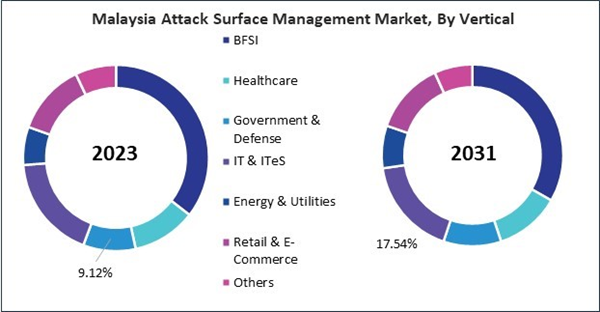The China market dominated the Asia Pacific Attack Surface Management Market by Country in 2023, and would continue to be a dominant market till 2031; thereby, achieving a market value of $434.8 million by 2031. The Japan market is registering a CAGR of 30.8% during (2024 - 2031). Additionally, The India market would showcase a CAGR of 32.4% during (2024 - 2031).
Attack surface management solutions help organizations meet regulatory compliance requirements and industry standards by providing visibility into their security posture and adherence to security best practices. By generating comprehensive reports and audit trails, organizations can demonstrate compliance with regulations such as GDPR, HIPAA, PCI DSS, and others, reducing the risk of non-compliance penalties and reputational damage.
Moreover, attack surface management solutions enable organizations to assess and manage third-party risk by identifying and monitoring dependencies, relationships, and potential attack vectors associated with external vendors, partners, and suppliers. Organizations can mitigate the risk of supply chain attacks, data breaches, and other security incidents by conducting continuous assessments and due diligence on third-party assets and connections.
As per the International Trade Administration, China had the largest state-run education system in the world, with 291 million students and 18 million teachers in over 529,000 schools in 2021. The nation’s education technology sector entered a rapid growth stage from 2017 to 2020, with the industry’s total revenue increasing from $46.4 billion to $61.1 billion. The total revenue of China’s education technology sector continues to rise and is expected to reach $75 billion by 2022. Thus, the growing education and fintech sectors in Asia Pacific will drive the expansion of the regional market.
Based on Deployment Mode, the market is segmented into Cloud, and On-premise. Based on Component, the market is segmented into Solution, and Services. Based on Enterprise Size, the market is segmented into Large Enterprise, and mall & Medium Enterprise. Based on Vertical, the market is segmented into BFSI, Healthcare, Government & Defense, IT & ITeS, Energy & Utilities, Retail & E-Commerce, and Others. Based on countries, the market is segmented into China, Japan, India, South Korea, Australia, Malaysia, and Rest of Asia Pacific.
List of Key Companies Profiled
- Palo Alto Networks, Inc.
- IBM Corporation
- Microsoft Corporation
- Cisco Systems, Inc.
- Google LLC (Alphabet Inc.)
- Trend Micro, Inc.
- Qualys, Inc.
- Tenable Holdings, Inc.
- Crowdstrike Holdings, Inc.
- BitSight Technologies, Inc.
Market Report Segmentation
By Deployment Mode- Cloud
- On-premise
- Solution
- Services
- Large Enterprise
- Small & Medium Enterprise
- BFSI
- Healthcare
- Government & Defense
- IT & ITeS
- Energy & Utilities
- Retail & E-Commerce
- Others
- China
- Japan
- India
- South Korea
- Australia
- Malaysia
- Rest of Asia Pacific
Table of Contents
Companies Mentioned
- Palo Alto Networks, Inc.
- IBM Corporation
- Microsoft Corporation
- Cisco Systems, Inc.
- Google LLC (Alphabet Inc.)
- Trend Micro, Inc.
- Qualys, Inc.
- Tenable Holdings, Inc.
- Crowdstrike Holdings, Inc.
- BitSight Technologies, Inc.









